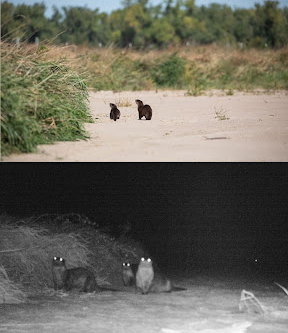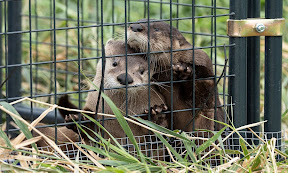Photograph By Matt Urbanski -Both female river otters shortly after entering their new enclosure at Crane Trust.

Top photograph by Carlee Moates -Both female otters exploring the Platte River after being released.
Bottom photograph by Megan Soldatke -Why it’s her favorite: “I love this picture because it shows an accomplishment for not only the river otters, but the Crane Trust and Nebraska Wildlife Rehab. It shows that the otters kept their natural instincts and were able to successfully form a relationship with a wild river otter, increasing their chance for a long, wild life.”
Recently, the Crane Trust had the unique opportunity to help Nebraska Wildlife Rehab with the release of two juvenile river otters on Crane Trust Property. River otters present an uplifting story of conservation success in Nebraska. In the 1900s, river otters were extirpated from the state due to unregulated harvest and habitat degradation. However in the late 1980s, Nebraska Game and Parks Commission made efforts to restore the population by releasing river otters throughout the state including in the Central Platte River. Because of those efforts, Nebraska is now home to a viable and expanding population of river otters. In 2020, river otters were even removed from Nebraska’s list of threatened species. The Central Platte River is the best river otter habitat in the state and where the Trust is located has been identified as a core area for otter distribution in Nebraska (Bieber et al. 2018). While the Crane Trust’s restoration and management efforts are focused on preserving Whooping Crane and Sandhill Crane habitat, the Trust also emphasizes that a healthy and resilient ecosystem for cranes requires healthy populations of all native species.
At Nebraska Wildlife Rehab
These otters came from Nebraska Wildlife Rehab (NWR) in Omaha. Carly Portinen, their Rehabilitation Coordinator, and others took care of two female juvenile otters, preparing them for a life in the wild, which was an opportunity they would not have had without this organization’s hard work and expertise. According to Carly, the otters arrived at NWR this spring; both from separate litters and around a couple of months old. She said, “They were first kept separate until they were both dewormed and vaccinated as a precaution, as well as ensuring they were somewhat used to each other’s presence before being combined into one space. Once combined they took to each other Immediately!”
Once it was safe to have the two together, the otters were weaned off formula. From here the rehabilitation team started introducing new foods to their diets and new water sources. I was told that young otters are not fully waterproof and do not become so until later. This meant that they had to slowly introduce larger and larger pools and even teach them how to swim. This was one of Carly’s favorite experiences since it benefited the otters and was funny at times. Besides swimming she said, “It’s amazing being able to watch them learn new things and grow into adulthood! My favorite thing about rehab in general is getting to watch our patients grow and develop; getting to be a part of their journey is so rewarding.”
Eventually, they ended up in a larger outdoor enclosure with a good-sized pool. After a couple of months there, they were brought to their soft-release enclosure at the Crane Trust.
At Crane Trust
After their music-less drive from Omaha to the Crane Trust, the otters were given an enclosure on riverfront property next to the Platte River for one week. Bethany Ostrom, Wildlife Biologist, Megan Soldatke, Lila O. Wilson Biological Monitoring Fellow, and myself were responsible for taking care of these otters. We had to follow a couple of important rules while caring for them. One, we were not allowed to interact with them besides the necessary time spent cleaning and feeding them. Two, we were not allowed to talk while within earshot of them. Otters are adorable and very social animals, but we wanted human voices and interactions to be unfamiliar and hopefully deterring if ever encountered. This is very hard to do since the otters come up to you while you clean their enclosure and feed them. Any thoughts of playing with them or petting these water puppies had to be kept under control. After all, they are wild animals, and treating them like they are tame could put them in danger in the long run. During this time we cleaned their enclosure and brought them fish every day. Cleaning entailed picking up leftover fish heads, rearranging crates, cleaning off blankets and sheets, bringing in some river debris, cleaning out their pool, and refilling their pool with river water. After one week we opened their enclosure, letting them come and go as they would like and leaving food for them once a day.
On the day of the soft-release Carly Portinen arrived to lead the release, and Carlee Moates, a Storyteller from Platte Basin Timelapse (PBT), came to take photos. PBT’s goal is to inspire care for our land and water and connect our neighbors up and downstream – all through the power of story. She said “This particular story about these charismatic otters will be an engaging one telling times of trial and hope and was too much for me as a mammal-lover to pass up. This PBT Project will have a presence at the National Wildlife Rehabilitators Association Symposium this upcoming spring, so sharing a rehab-specific wildlife story will link our audience to what PBT does with storytelling through the environment at large, as well as introduce people from all over the nation to our extraordinary Crane Trust!”
Carlee’s photos were shared with us and with NWR. At the beginning of this blog, you can see her amazing work!
A week after the soft-release they were fed every other day to begin weaning them from this food supply. After one more week, we only fed them once every three days and took any form of habitat enrichment out of the enclosure. By the time we knew both otters were thriving and did not rely on our free buffet, they were ready to be fully on their own. We stopped feeding them and removed their temporary enclosure.
Megan’s favorite experience was when we saw one of the otters while bringing food out after the release. She said, “They ran away as soon as we saw them, so we hid and waited. After a few minutes they came back, cautious, but sniffing for the food we had just dropped in their open enclosure. The otter went and enjoyed some of the fish, but eventually ran back to the river. We watched them swim down the river, and I felt so proud to have helped this otter return to where it should be… floating down the river and munching on fish.”
Bethany’s favorite experience was after the soft release when both otters played in the sand on the bank. She said, “Otters are so curious and naturally playful, and seeing that come out even when they were in a new environment was heartwarming. I think that spoke to how at home they felt on the Platte.”
My favorite experience occurred every time I was able to help maintain the otter’s enclosure. Filling five-gallon buckets with water, struggling to carry them back to the enclosure, and then getting to fill the otters’ small pool. When an animal that is so connected to the river is finally given water after half a day of no water, because they splashed it all out of the pool, they are ecstatic. That is where they belong, so it was very rewarding to carry water for them as they acclimated to their new surroundings.
Disclaimer
Otters are wild animals and require very specific care. You should not rehabilitate or keep any wild animals yourself. Using this website from NWR you can read more about why you should not rehabilitate or keep wild animals and find guides on what you should do when you find abandoned or injured wildlife. You should never touch abandoned wildlife without going through the appropriate guide first.
Overview : Found a Wild Animal? : Wildlife Help : Nebraska Wildlife Rehab, Inc.
I hope you enjoyed reading about Nebraska Wildlife Rehabilitation and Crane Trust’s recent otter release!
Matt Urbanski,
Saunders Conservation Fellow
murbanski@cranetrust.org
Sources:
Bieber, N. R., S. P. Wilson, and C. R. Allen. (2018). River otter distribution in Nebraska. Wildlife Society Bulletin 42(1): 136-143. http://digitalcommons.unl.edu/natrespapers/840

